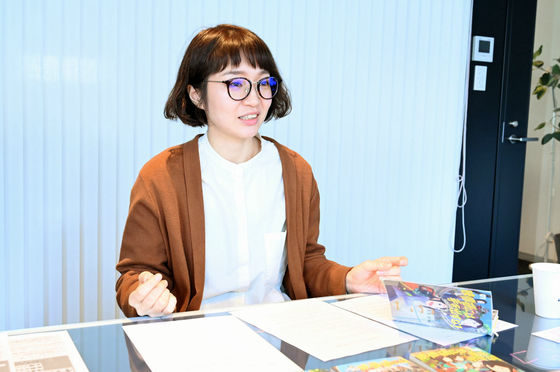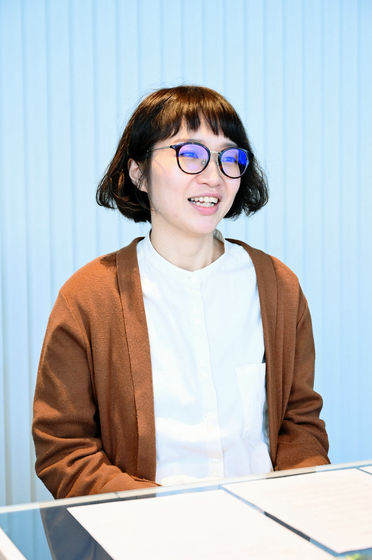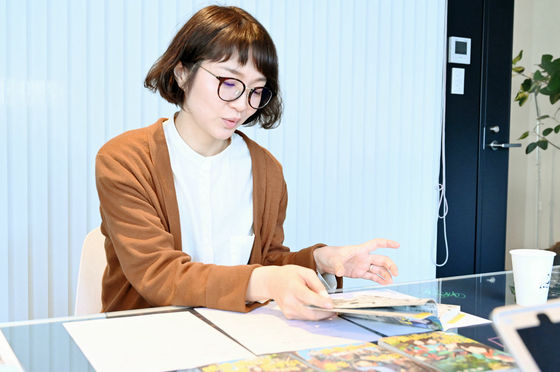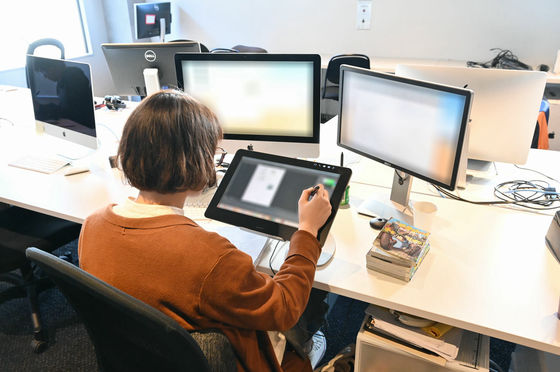Interview with Takuko Takahata, a prop designer who designed the small objects to have a persuasive power as an animation.

A TV animation based on Sumito Owara's manga, 'Don't Do anything for Video Lab! ', Will start on Sunday, January 5, 2020. In connection with this work, director Yuasa and three main casts are at the
TV animation 'Keep Your Hands Off Eizouken! 'Official site
http://eizouken-anime.com/
GIGAZINE (hereinafter G):
Mr. Takahata is in charge of the prop design of 'Don't put your hands on the image research!'
Takuko Takahata (Takahata):
Yes. I was in charge of the first episode. Since 'Iken' is made faithfully to the original work, I try to make the small items in the original work convincing so that the animator can draw at various angles. I will.

G:
'To make it easy to draw' means that it may be difficult to draw as it is.
Takahata:
If it's a single picture, it's cool to draw it, but in animation, 'moving' is important, so I omit the design. However, if you omit too much, you will get a cheap image, so it is difficult to balance. In the first episode, it was the first time, so I drew the setting in detail, but when I saw the animation, the animator skipped it well and I learned.
G:
For example, what kind of item is in the first episode?
Takahata:
Asakusa's binoculars, their mobile phones, sketchbooks, etc. Another person worked on the sketchbook, but I was in charge of the outside design.
As for the images below, apart from what Asakusa is drawing, the design of the 'ring part of the sketchbook' and 'pen' is the prop design.

Takahata:
Also, milk and drinks that Kanamori has. I asked the creators to find out about the trademark, and finally, it became 'strawberry milk'. I was in charge of everyday items.

G:
What is it that you draw in detail?
Takahata:
Binoculars and tools. I couldn't draw if I didn't know how it was made, and I would look at the photos for reference, but there were some parts that I couldn't understand if only the photos were taken, so I actually went to a home appliance retailer to check for myself. There was also a thing.
G:
There are some parts that are not enough in the photo.
Takahata:
There are things that I can't understand without holding something like 'What's going on the back?' And 'Why is there a protrusion here? What is this for?' If you draw it only with an image, the animator will be in trouble later, so I wanted to understand that kind of place before drawing. Since I am also in charge of animation, at first I thought that the difficult part was omitted when I drew it, but I was convinced by Mr. Motohashi, who directs (1st episode), that it is better to draw properly here. did. In the end, the animator draws according to the scene.

G:
In the first place, what was the background of being in charge of prop design?
Takahata:
I've been interested in design for a long time, so I raised the idea of doing it. I had experience in designing itself before entering Science SARU, but the process was different, or it was my first time designing a Japanese animation, so I was able to participate and learn from the first idea generation. It was
G:
So that's it.
Takahata:
I will arrange and put out what is in the original, but my drawing is an ant as an illustration but there is a point that it does not work a little in animation design, so proper perspectives, shadows, how to put highlight instructions etc. I came while teaching me.
G:
What is the point that there is a definite difference between the design as an illustration and the animation?
Takahata:
I think animation needs more persuasiveness. With one illustration, it doesn't matter what the backside of what you are drawing. For example, the appearance of complicated shapes like the binoculars that I mentioned earlier changes depending on the angle when viewing from the front, the side, and the top. will become necessary. I also wondered if an animator would be helpful when such a scene appeared, as there is also an open / close version when the eye width of the binoculars is changed. I think the purpose is different from the illustration.
G:
Certainly, it's different from the original idea. How many props did you have to draw in 'Don't put your hands on the video lab!'?
Takahata:
About 20 to 30? Although it is the first episode main, I am adding supplementary accessories that are not enough in the number of later episodes.
G:
Do you have a design that left an impression on you?
Takahata:
The food was difficult. Also, I couldn't draw a cute rabbit stuffed animal that Daido cherishes.
(All laughs)
Takahata:
I wanted to draw it cutely because I had a particular feeling, but it didn't go well ...
Original author's pic.twitter.com/93P1yzc37f
— Daido Sumito Owara (@ dennou319) December 29, 2019
G:
Is there something that didn't work?
Takahata:
I think it's a millimeter difference. I had to fix the eyes a little differently, fluffy feeling, etc. Many times, I fixed it and corrected it to the current shape.
G:
Is it in millimeters ...
Takahata:
It looked so simple and I shouldn't make a mistake, it was a bit of pressure (laughs).
G:
What was difficult about food?
Takahata:
In the first place, I didn't often draw the food itself with animation. So, first of all, from the point of 'how to draw', I looked at other animation materials and painted to see how they are divided. If you make ramen noodles too finely, it doesn't look so good, or it doesn't look so delicious.

G:
Hoho.
Takahata:
When I saw the scene where the ramen actually came out, it was processed well, but it was something I had never drawn, so I searched for “how to draw it well” It was
G:
Just because you draw it doesn't mean it looks delicious.
Takahata:
I agree. The lines are drawn with black lines and the appearance changes because they are softer and softer with different colors, so I was doing it through various trial and error.
G:
Having an original doesn't mean that prop design can be done easily.
Takahata:
I think that it will be faster than the prop design of the original work because there are things that can be used as references, but there were many difficult points ...
G:
It is like an image of translating the original design for animation.
Takahata:
It's weird to say 'adjust', but there are things that need to be unified in size and feeling when you hold it, so it's like making it 'usable in animation'. I think it would be harder for animators to make the design as simple as possible, but it's difficult to balance it.
G:
How do you finally balance?
Takahata:
'Persuasiveness' and 'function' cannot be said to be 'unless there is this'. For example, if you only want to make the impact driver of the tool simple, it may be like a switch with a box-like shape without the square box-shaped projection below, but since the battery is included, its lid is I was aware of the fact that I had to draw absolutely. However, if it does not affect the animation or story even if it exists, I think that it is easier to animate it if it is omitted.
G:
It is a convincing design that builds upon such reasoning.
Takahata:
I agree.
G:
Mr. Takahata is in charge of not only prop design but also storyboards in the latter half of the story.
Takahata:
Yes. I had no experience, but I wanted to try it someday. I might be afraid of my failure, so I might have declined, but I had a strong desire to try it. There is a big desire for the company, including the producer, Unyeon, to 'make people who are motivated to take on challenges,' and I agree with that policy, so I try to put pressure on myself.

G:
I think that you were responsible for the prop design and the storyboard, so you had to read the original a lot, but what was your first impression of the work?
Takahata:
I had the impression that I was very particular about the settings ... I thought that it seemed difficult, because the mechanics also came out. I've never done a style work like this, so I wondered, 'How do you do it?' There were many new challenges from scratch.
G:
Is there any part that made this a challenge in your work production?
Takahata:
I thought it would be interesting to change the style in the real world and the image world as a policy of the work rather than an individual. As I read the original, the real world and the world of images suddenly switch, so I was wondering what I would do to make it easier for the viewer to see the animation.
G:
Even with the 'propeller skirt', the delusion was directly connected to reality. How do you make the storyboard work?
Takahata:
The idea is to read the script and draw out the ideas in a rough way, but at the beginning, I draw only the main picture without drawing too much detail, and then gradually add in between.

G:
Does Director Yuasa give detailed instructions regarding the storyboard? Or do you leave it to me?
Takahata:
In a meeting called “conting,” Director Yuasa explains the image while reading the script, and asks if there are any questions. This time, the episodes 9 to 12 are especially connected, so I deepened my understanding of the flow and what is happening when there are similar cuts. Director Yuasa will draw an image when you hit the storyboard, but the details are like 'try it'. I think that there is an image in the director's mind, but I do not have the impression that each one is instructed in detail.
G:
What is your impression of the original story about Mr. Takahata's three daughters?
Takahata:
All three have different personalities, but they accept each other and are working well, and I think it's amazing that they are so absorbed. When I was a high school student, I felt like similar people were hanging around, and I hadn't seen many people who had jumped so far.
G:
Sounds fun.
Takahata:
Director Yuasa was also talking about a secret base, but when I was small I also went outside to play and made a secret base, so I saw Asakusa delusional There are things like “I did it!” (Laughs), but the great thing about Asakusa is that I don't draw what I see on the spot, but rather I remember it as an image and draw it later. I don't have that ...
G:
I'm a little away from the work, why did Mr. Takahata become an animator?
Takahata:
Originally, I used to draw a caricature at a shopping mall, but when I was drawing it, I thought, 'Isn't it more interesting that my own painting moved?', So I wanted to learn animation.
G:
Portrait drawing! It's amazing.
Takahata:
I think everyone can get a job in college. So when I said, 'What kind of work do you want to do?' I didn't have anything to do. The only thing I wanted to do was 'I want to draw a picture', but I wasn't from a university of art ... I don't really pick up designers who aren't from university or inexperienced people. The result of looking for a place to put in was a portrait.
G:
So that's it.
Takahata:
I had thought that I wanted to make an animation, but I wasn't so interested in 'animation' itself, so I didn't choose an animator first. However, when I was in Canada, when I saw Yuasa's work, it was different from what I thought of the anime, so he said, 'This person is different.' The movement was interesting, and I was shocked and started paying attention.
G:
After working as an animator in a Canadian studio, he returned to Japan and entered Science SARU.
Takahata:
The main reason is that I also want to contribute to Yuasa's work. While there are various styles of work, I felt that the work of Science SARU was challenging, and I thought it would be fun.
G:
How long was it that you were happy when you actually participated?
Takahata:
There is a lot of pressure to make a work, but it's rewarding and fulfilling to see that the work is completed. Many people around me respect me, so I'm grateful to be able to work with them.
G:
So that's it. I'm looking forward to the episode 11, which is in charge of storyboards, as well as props. Thank you for today.
・ Continued

Related Posts:






